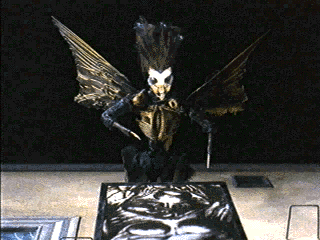The strange animations of the Brothers Quay
(TW: theory-speak. This is from an academic paper, and reads like it.)
This is a post I made long ago but can’t find; I’m reposting it for eldritch-horrors and others who love strange dark things.
Remember Ray Harryhausen? Great stop-motion animator, did the animations for Jason and the Argonauts and Clash of the Titans? Imagine Ray Harryhausen on meth rummaging through your great-grandmother’s attic. That’s what the stop-motion films of the Brothers Quay are like. Their materials are very often domestic junk-draw stuff, homey and pitiful, but their effects are otherworldly, alien and strange. Objects remove themselves from their original functions (screws dance out of their holes, dolls stop playing) and move purposefully away on their own unknowable missions; they give the films a hectic dreaming quality. The term “stop-motion” itself captures in its contradiction one enigma of the Quay’s work: a sense that whatever moves has until now been static, waiting; that whatever holds still has something moving inside it greater than the sum of its possible gestures. This is inanimate life and living remains. Animating the inanimate object, it defamiliarizes the human subject. The objects have intents and purposes, even opinions, a kind of kinetic affect; the more human figures seem blank, oddly passive, often worked upon by these subjectified, totemic puppets.
There’s no plot here: the viewer’s effort to understand or build a narrative becomes not only futile but palpably frustrating, working against the film’s resistance in a way that heightens one’s desire for hermeneutic closure. What’s most interesting happens just out of frame or beyond the focal length: “One eye should be plunged into a microscope and the other into a telescope” (Quay commentary on “Stille Nacht”).
Here’s an image from “The Epic of Gilgamesh, or This Unnameable Little Broom”:

And here’s a description, from J. D. McClatchy: “The Gilgamesh figure is a sort of grotesque fascist hydrocephalic child despot on a tricycle, ruthless patrolling his sandbox kingdom. Enkidu, made from a bird skull adorned with an exotic headdress of feathers and shells, brings to mind Max Ernst’s renowned collage series Une Semaine de Bonté.”
Why did they choose this story to animate? Why the Epic of Gilgamesh? We found this epic on crumbling clay slabs in Akkadian garbage dumps, tablets used by children learning how to write by copying the classics. Our trash heaps are our histories. We rebuild our stories from the fragments of old mythologies, and move them in ways that don’t try to be natural but thus, somehow, are.